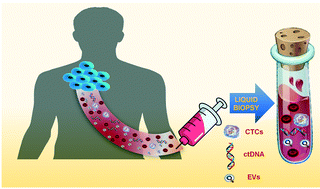Cancer diagnosis: from tumor to liquid biopsy and beyond
Abstract
Technological advancements in research on circulating biomarkers from patient derived blood have enabled a less invasive means of diagnosing non-hematologic cancers. Considered a more practical way of real-time patient monitoring than traditional tumor biopsy, liquid biopsy markers including circulating tumor cells (CTCs), circulating tumor DNA (ctDNA) and extracellular vesicles (EVs) and exosomes certainly have the potential to change the dynamics of cancer management and treatment. Liquid biopsy essentially presents a snapshot of the disease from the primary and/or distant tumor locations and can be utilized for repeated sampling of tumor markers to adjust therapy according to the patient's response to treatment, also known as personalized or precision treatment. In this review, we discuss the research progress in this field with respect to each of the liquid biopsy markers ranging from CTCs, EVs to ctDNA. First, we highlight key CTC technologies that have been commercialized and extensively employed for patient sample analysis. Next, we present some recent developments with regards to exosome and ctDNA research. We then conclude with some future perspectives on the areas of research for these biomarkers. Taken together, we believe these non-invasive capabilities and their potential for diagnostic development can influence treatment selections and aid precision cancer therapies.

- This article is part of the themed collections: Personalised Medicine: Liquid Biopsy and Lab on a Chip Recent Review Articles


 Please wait while we load your content...
Please wait while we load your content...